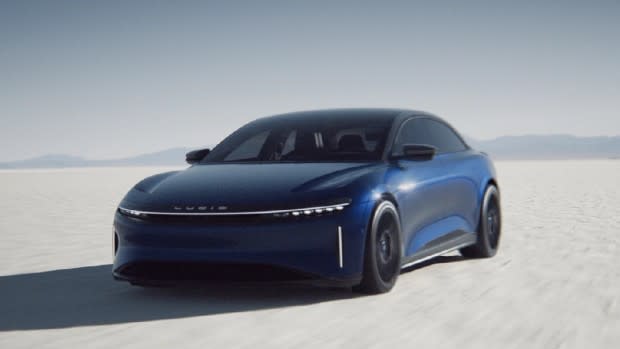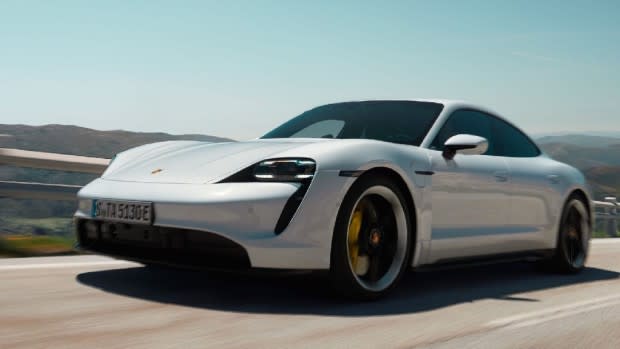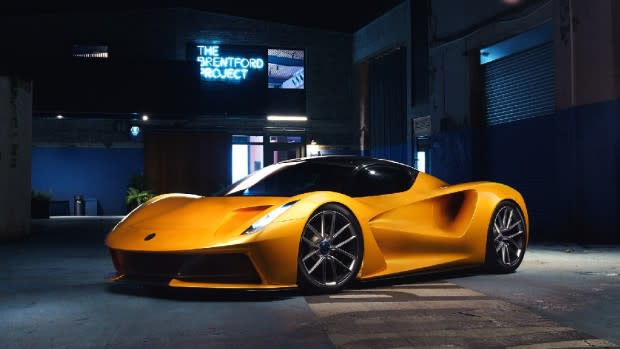Horsepower Now Means Nothing
Nothing is fast anymore. I don’t care about your Dodge Demon, your 1,000-horsepower Camaro resto-mod, or your exotic European supercar. Nothing is fast anymore.
I blame electric cars and, therefore, Elon Musk. Did we ever need a five-seater Tesla Model S that can log 0-60 times in the low two-second range? Absolutely not, but Musk recognized early on the ability for instantaneously available torque to reshape traditional conceptions of power and speed.
We would be living in a golden age of 1,000-horsepower supercars—like the 1,500 hp Bugatti Chiron Super Sport I recently drove—if not for the electric car. It's not that EV-favoring regulations are holding back V8 or W16 monsters (they aren't). It's that even commuter EVs can embarrass most internal-combustion monsters on a drag strip. The simple straight-line speed that electric drivetrains allow, simply put, borders on ludicrous—Tesla pun fully intended.
In a way, the old horsepower wars have become a thing of the past, since even moderately powerful cars these days quickly run out of road before reaching anything near their limits. Even on a track, 140 miles an hour on the straightaway feels a little underwhelming since a Lucid Air Sapphire can hit that in about seven seconds. But if horsepower counts for less and less with each passing year, what matters more?
Simply put, torque will reign as the most important stat in the modern automotive age.

Talking Horsepower and Torque
You want math to prove the point? We’ve got it.
First, in the traditional relationship between horsepower and torque, there's a linear correlation. To get a bit more complex, torque is a unit of force, but the torque measurements we use for an engine are technically work. Hence the concept of foot-pounds or pounds-feet, semantics aside, where “foot” measures the distance at which “pounds” of force are applied.
Think of using your hands to crank on a wrench that measures one foot long. How many pounds of force does that put on a nut or bolt?
Now, how much work would your puny hands need to do to spin that wrench all the way around steadily while moving a car that weighs literal tons?
Work multiplied by frequency equals power—or, more accurately, power is the rate of doing work. In the case of engine stats, one horsepower equals 33,000 foot-pounds of work per minute. A bit more than my biceps can manage, to say the least.
Related: Tesla Enters the Race to Electrify Adventure Rigs
We measure power by multiplying torque times hertz, or rpm: As revs increase, if torque output stays the same, then horsepower goes up linearly. But an internal-combustion engine doesn’t produce the same torque at every rpm, instead needing time to reach peak torque. Hence a dynamometer sheet—or dyno—which charts both torque and horsepower output.
But the torque and horsepower lines on a dyno sheet always cross at 5,252 rpms (more math required here, but rest assured that the numbers work), which explains why high-performance racing engines typically rev as high as possible to produce as much horsepower as possible at all times.
For road cars, turbochargers and superchargers help produce low-end torque by compressing air to increase the amount of combustible oxygen. This improves fuel economy for commuters while also giving sports cars more grunt for hard launches when they’re not revved up towards redline.
Still, even the fastest gas cars need to spin up to where they produce more horsepower. So automakers spend billions trying to reduce the lag time to get to peak torque and then high horsepower.
Just look at the recently revealed Dodge Challenger SRT Demon 170, which uses a supercharged 6.2-liter Hemi V8 pumping out up to 1,025 horsepower. With line lock to warm up its tires and a transmission brake to hold the revs high (and thereby reduce the lag time required to reach peak torque and horsepower), the Demon 170 can log a claimed quarter-mile time of 8.61 seconds (on prepped asphalt).

Courtesy Image
EV Supremacy on the Horizon
As awesome as hard launches in a Demon 170 or Bugatti Chiron Super Sport might be, electric cars already far exceed their performance. A Tesla Model S Plaid costs 1/30 as much as a Chiron Super Sport and can seat five adults comfortably, but still manages a 2.3-second 0-60 time. That Lucid, on the other hand, uses three electric motors to launch to 60 mph in 1.89 seconds while pulling to over 200 mph—and it also seats five.
The world-beating Rimac Nevera hyper-EV recently set records for a production car with a 0-60 time of 1.74 seconds, a 0-100 time of 3.21 seconds, and a (Demon 170-smashing) quarter-mile of 8.25 seconds.
EVs dominate drag strips for one simple reason: Electric motors can reach peak torque at only 1 rpm, in effect instantaneously. And many can rev much further past 5,252 rpm, well up to 15,000 or even 20,000 rpm. The instantaneously available torque produces that gut-punching acceleration, to the point that tire traction quickly becomes more important than actual power output.
Related: 50 Best Whiskeys in the World 2023
As tires gain grip and engines spin up into the power band, potential acceleration increases (the official term for the rate of change of acceleration is "jerk," so Teslas driven by jerks become all the more hilarious).
Effective gearing also benefits electric motors mightily. Lucid’s motors can actually drive upwards of 5,000 lb-ft of torque into the axles, but because the tire diameter reduces that by adding a larger radius (again, think of the wrench, in this case usually just over a foot) into the equation, estimates of the Sapphire’s real wheel-torque are more like 1,600 lb-ft. Still not bad, and plenty for peeling out to wow friends and family while shredding tires and embarrassing legit ICE supercars off the line.

Courtesy Image
Real-World Performance off the Drag Strip
Of course, real-world performance isn’t dictated only by 0-60 and quarter-mile times achieved on a prepped drag strip. And for the first two decades of the burgeoning electric era, most EVs lost that effectiveness at higher speeds as batteries heated up during periods of high output and gearing became a limiting factor. But battery technology continues to improve (Moore’s law almost applies here) and motors have gotten better, too.
Porsche even broke from industry trends by installing a two-speed gearbox in the Taycan to help with highway cruising and top-end acceleration. Not to mention the Rimac Nevera’s recent world record for highest speed ever recorded by a road-going EV, with a top speed of 258 miles per hour.
The Nevera’s official ratings come in at 1,914 horsepower and 1,741 lb-ft of torque—the latter being the reason for those eye-popping acceleration records, by cutting the time required to get to maximum shove.
So why do manufacturers still refer to horsepower at all? Well, for one thing, basic consumers and car enthusiasts still want to compare today’s EVs to traditional ICE cars, which they know better by horsepower output. (And as EVs increasingly use two, three, and even four motors, both horsepower and torque figures become a bit harder to accurately quantify, but that’s a whole different story.)

Courtesy Image
Driving Fun Is About More Than Just Power Stats
Consumers and car enthusiasts also know, or should know, that real-world performance doesn’t just come down to straight-line speed. I’m a firm believer in the joys of driving a slow car fast, finding the edge of traction and sanity at lower speeds with narrower tires and barely capable brakes and buzzy little engines that can only just manage triple-digit output stats. After all, handling and braking seriously affect driving fun—and so far, EVs tend to drive like boats compared to the lightest of their gas counterparts.
Even Lotus, the company so long dictated by founder Colin Chapman’s famous “simplify, then add lightness” maxim, now builds a “lightweight” hyper-EV with 2,011 horsepower and 1,256 lb-ft of torque—but the Evija’s 4,160 pounds nearly doubles the curb weight of a Lotus Elise, while shaving just about 1,000 pounds off the heft of a Rimac Nevera.
Of course, a Nevera can beat a Lamborghini Aventador in a mile sprint even spotting 300 yards, so maybe Rimac (and Pininfarina) can change my mind about what’s actually fast. But the whole package still matters when the magical combination of acceleration, cornering, and braking come together to create a well-rounded, engaging driver’s car.
Traditionally, power-to-weight ratios reflected the relationship between engine output, mass, and lap times or canyon-carving performance.
Related: Genesis Electrified GV70 Is the SUV to Make You an EV Convert
For EVs, though, torque is the more important stat. As batteries continue to become lighter and lighter—moving away from lithium-ion towards solid-state polymers and technology not yet invented—expect OEMs, consumers, and enthusiasts alike to start focusing more and more on torque-to-weight ratios in the seemingly inevitable all-electric age.
Hopefully one day, even the torque-to-weight ratios of today will fade into oblivion as we move into a bright new future where only lateral G forces make headlines anymore, since everything is fast in a straight line. And when everything is fast, nothing is fast anymore.